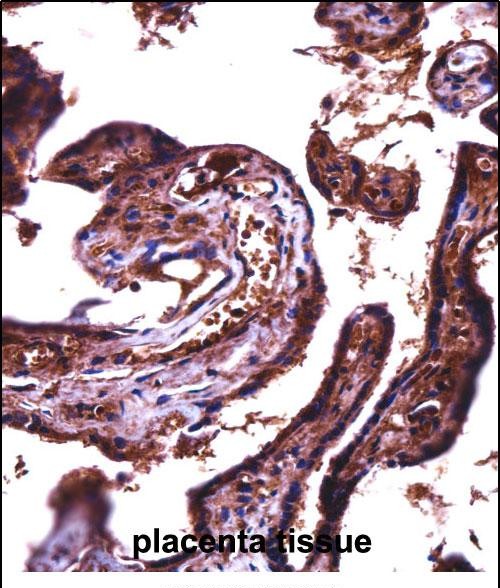JAM2 Antibody (N-term)
Affinity Purified Rabbit Polyclonal Antibody (Pab)
- 产品详情
- 实验流程
- 背景知识
Application
| IHC-P, WB, E |
|---|---|
| Primary Accession | P57087 |
| Other Accession | NP_067042.1 |
| Reactivity | Human |
| Host | Rabbit |
| Clonality | Polyclonal |
| Isotype | Rabbit IgG |
| Calculated MW | 33207 Da |
| Antigen Region | 63-91 aa |
| Gene ID | 58494 |
|---|---|
| Other Names | Junctional adhesion molecule B, JAM-B, Junctional adhesion molecule 2, JAM-2, Vascular endothelial junction-associated molecule, VE-JAM, CD322, JAM2, C21orf43, VEJAM |
| Target/Specificity | This JAM2 antibody is generated from rabbits immunized with a KLH conjugated synthetic peptide between 63-91 amino acids from the N-terminal region of human JAM2. |
| Dilution | IHC-P~~1:100~500 WB~~1:1000 E~~Use at an assay dependent concentration. |
| Format | Purified polyclonal antibody supplied in PBS with 0.09% (W/V) sodium azide. This antibody is purified through a protein A column, followed by peptide affinity purification. |
| Storage | Maintain refrigerated at 2-8°C for up to 2 weeks. For long term storage store at -20°C in small aliquots to prevent freeze-thaw cycles. |
| Precautions | JAM2 Antibody (N-term) is for research use only and not for use in diagnostic or therapeutic procedures. |
| Name | JAM2 (HGNC:14686) |
|---|---|
| Function | Junctional adhesion protein that mediates heterotypic cell- cell interactions with its cognate receptor JAM3 to regulate different cellular processes (PubMed:11590146, PubMed:11823489, PubMed:24357068). Plays a role in homing and mobilization of hematopoietic stem and progenitor cells within the bone marrow (PubMed:24357068). At the surface of bone marrow stromal cells, it contributes to the retention of the hematopoietic stem and progenitor cells expressing JAM3 (PubMed:11590146, PubMed:24357068). Plays a central role in leukocytes extravasation by facilitating not only transmigration but also tethering and rolling of leukocytes along the endothelium (PubMed:12239159). Tethering and rolling of leukocytes are dependent on the binding by JAM2 of the integrin alpha-4/beta-1 (PubMed:12070135). Plays a role in spermatogenesis where JAM2 and JAM3, which are respectively expressed by Sertoli and germ cells, mediate an interaction between both cell types and play an essential role in the anchorage of germ cells onto Sertoli cells and the assembly of cell polarity complexes during spermatid differentiation (By similarity). Also functions as an inhibitory somatodendritic cue that prevents the myelination of non-axonal parts of neurons (By similarity). During myogenesis, it is involved in myocyte fusion (By similarity). May also play a role in angiogenesis (By similarity). |
| Cellular Location | Cell membrane; Single-pass type I membrane protein. Cell junction. Cell junction, tight junction {ECO:0000250|UniProtKB:Q9JI59}. Note=Localized at tight junctions of both epithelial and endothelial cells (By similarity). Specifically localized within the somatodendritic compartment of neurons and excluded from the axon (By similarity) {ECO:0000250|UniProtKB:Q9JI59} |
| Tissue Location | Highly expressed in heart, placenta, lung, foreskin and lymph node (PubMed:10779521, PubMed:10945976). Prominently expressed on high endothelial venules and also present on the endothelia of other vessels (at protein level) (PubMed:10779521, PubMed:10945976). Also expressed in the brain in the caudate nuclei (PubMed:31851307). |
For Research Use Only. Not For Use In Diagnostic Procedures.
Provided below are standard protocols that you may find useful for product applications.
BACKGROUND
Tight junctions represent one mode of cell-to-cell adhesion in epithelial or endothelial cell sheets, forming continuous seals around cells and serving as a physical barrier to prevent solutes and water from passing freely through the paracellular space. The protein encoded by this immunoglobulin superfamily gene member is localized in the tight junctions between high endothelial cells. It acts as an adhesive ligand for interacting with a variety of immune cell types and may play a role in lymphocyte homing to secondary lymphoid organs. [provided by RefSeq].
REFERENCES
Need, A.C., et al. Hum. Mol. Genet. 18(23):4650-4661(2009)
Ueki, T., et al. Microvasc. Res. 75(2):269-278(2008)
Weber, C., et al. Nat. Rev. Immunol. 7(6):467-477(2007)
Liu, T., et al. J. Proteome Res. 4(6):2070-2080(2005)
Zhang, Z., et al. Protein Sci. 13(10):2819-2824(2004)
终于等到您。ABCEPTA(百远生物)抗体产品。
点击下方“我要评价 ”按钮提交您的反馈信息,您的反馈和评价是我们最宝贵的财富之一,
我们将在1-3个工作日内处理您的反馈信息。
如有疑问,联系:0512-88856768 tech-china@abcepta.com.























 癌症的基本特征包括细胞增殖、血管生成、迁移、凋亡逃避机制和细胞永生等。找到癌症发生过程中这些通路的关键标记物和对应的抗体用于检测至关重要。
癌症的基本特征包括细胞增殖、血管生成、迁移、凋亡逃避机制和细胞永生等。找到癌症发生过程中这些通路的关键标记物和对应的抗体用于检测至关重要。 为您推荐一个泛素化位点预测神器——泛素化分析工具,可以为您的蛋白的泛素化位点作出预测和评分。
为您推荐一个泛素化位点预测神器——泛素化分析工具,可以为您的蛋白的泛素化位点作出预测和评分。 细胞自噬受体图形绘图工具为你的蛋白的细胞受体结合位点作出预测和评分,识别结合到自噬通路中的蛋白是非常重要的,便于让我们理解自噬在正常生理、病理过程中的作用,如发育、细胞分化、神经退化性疾病、压力条件下、感染和癌症。
细胞自噬受体图形绘图工具为你的蛋白的细胞受体结合位点作出预测和评分,识别结合到自噬通路中的蛋白是非常重要的,便于让我们理解自噬在正常生理、病理过程中的作用,如发育、细胞分化、神经退化性疾病、压力条件下、感染和癌症。







